
SPRING 2022 | VOLUME 100 NUMBER 2 OUT IN THE CLASSROOM: LIVES, LESSONS, AND RESOURCES THERAPEUTIC BENEFITS OF ARTMAKING SUPER SUMMER PODCAST PLAYLIST PRIDE EDITION MINISTER OF EDUCATION WAYNE EWASKO TAKES HELM

CONTENTS SPRING 2022 | VOLUME 100 NUMBER 2 As ‘out’ teachers and spouses, Chantelle Cotton (she/her) and Kim Brown (she/her) know firsthand the importance of making a school a safe and open space for everyone. And while schools have made a lot of strides in inclusion in the past few decades, as language and thinking shifts, the need for ongoing education remains. 8 COVER STORY INCLUSION WORK IS NEVER DONE: THE NEED FOR ONGOING EDUCATION REMAINS FROM THE PRESIDENT5 FROM THE GENERAL SECRETARY7 THE THERAPEUTIC BENEFITS OF ARTMAKING 24 MENTAL HEALTH RESOURCES FOR TEACHERS THE PRINCIPAL OF THE THING GREAT SUMMER PICKS FOR YOUR PODCAST PLAYLIST 28 30 32 8 BOOK REVIEWS PG.34 10 RAINBOW RESOURCE CENTRE HERE TO HELP 12 ARQUIVES: KEEPING 2SLGBTQIA+ STORIES ALIVE 13 MTS 2STLGBQIA+ AD HOC COMMITTEE REPORT
A NOTE TO THE READER:
You
directly
Last January, Jean-Paul left her role as principal of Ecole Templeton, joining Louis Riel School Division to advance comprehensive progress on diversity, inclusion and anti-racism services. She’s still teaching, but her classroom looks different today than it has throughout her career.

Justice
The Canadian Teachers’ Federation’s new resource Affirming Gender Diversity booklet supports teachers in raising awareness and addressing questions from students around diversity of gender, as well as social concepts such as cisnormativity, cissexism and transphobia, through the students’ own experiences.

OF EDUCATION
With the growing challenges in the K-12 public education system and the many opportunities for positive change, the appointment of Wayne Ewasko, MLA for Lac du Bonnet, a former teacher, as Minister of Education and Early Childhood Learning is a welcomed move.

16 14 20 GROWING THE INCLUSIVE CLASSROOM: MICHELLE JEAN-PAUL DRIVES SYSTEMIC CHANGE GENDER DIVERSITY IN CANADA: ONE STUDENT VOICE AT A TIME NEW MINISTER
WAYNE EWASKO: FORMER TEACHER TAKES HELM 16 14 20
may notice a variety of acronyms in our Pride related stories. All the acronyms used are
quoted from our interviews. Per the position of the MTS Equity and Social
Standing Committee and the MTS 2STLGBQIA+ Ad Hoc Committee, the Society encourages groups to decide amongst themselves what acronym best suits their needs and comfort.
EDITOR
Anne Bennett
ART DIRECTION AND DESIGN
Krista Rutledge
PHOTOGRAPHY
Matea Tuhtar
CIRCULATION
Jennifer Nasse
ADVERTISING
Matea Tuhtar advertising@mbteach.org
SUBSCRIPTIONS
The MB Teacher is published three times a year by The Manitoba Teachers’ Society.
and views published herein do not necessarily represent the policies nor the views of the Society.
by The Manitoba Teachers’ Society.
CONTRIBUTORS
Wes Delve
PAGE 14
Wes Delve is a program officer with the International and Social Justice Program at the Canadian Teachers’ Federation (CTF/FCE). Before joining the CTF/FCE in 2018, Wes was a classroom teacher and a member of ETFO for 25 years, where he served as an equity representative, LGBTQI+ staff alliance facilitator, and delivered many ETFO equity-themed workshops.


Christine Deckert
PAGE 24
Christine Deckert has worked as an art specialist and educator since 2005 in both the private and public sectors, while establishing herself as a visual artist. A teacher at Frontenac School and member of the Louis Riel Teachers’ Association, Christine always enjoys sharing her love of art and culture with students.
Cynthia Thoroski
use or
without prior approval
strictly
THE MANITOBA TEACHERS’ SOCIETY
191 Harcourt Street
Manitoba R3J 3H2
PAGE 28
Cynthia Thoroski is the communications and marketing coordinator with the Canadian Mental Health Association, Manitoba and Winnipeg. She has worked in communications for over 17 years, supporting large-scale initiatives in healthcare, mental health, and environmental stewardship.


Curtis Lowton
PAGE 34
Curtis Lowton is a grade 7/8 teacher at Samuel Burland School. Prior to teaching in Winnipeg, he taught in Waskada, Manitou, and northern BC. He is a member of the MTS Equity & Social Justice Standing Committee and member-at-large for the Louis Riel Teachers' Association. An avid reader, Curtis enjoys books that expand both his professional practice and personal enjoyment.
abennett@mbteach.org
krutledge@mbteach.org
mtuhtar@mbteach.org
jnasse@mbteach.org
Articles
©2022
Unauthorized
duplication
is
prohibited.
Winnipeg,
Phone: 204-888-7961 Fax : 204-831-0877 PUBLICATIONS MAIL AGREEMENT 40063378 ISSN 002-228X Return undeliverable Canadian addresses to Contact Services at The Manitoba Teachers’ Society. /manitobateachers /mbteachers
SPRING 2022 www.mbteach.org
THE PRESIDENT
NOT AN EASY SCHOOL YEAR
Summer is almost here. We can see it—just ahead—like the longed-for destination of a weary traveller. Like its predecessor, this school year has not been an easy one, for us or for our students. We have struggled, we have learned, and we have made it to the finish line.
So, with our sunny destination in sight, what happens now?
The cumulative effects of the pandemic are undeniable, with extensive impact on both our personal and professional lives. Try as we might, there is no way to uncouple the two. We are human beings—who teach. And we bring all of our humanity into the classroom.

BUILDING RELATIONSHIPS
Education, like life, is all about relationships; whether they be rooted in building trust with students, engaging with parents, partnering with colleagues, or working with government. And one of the biggest casualties of this pandemic has been the health of our relationships.
When relationships are strained, we can be diverted from our true purpose, and the withering impact of that diversion cannot be overstated: we are teachers, first and foremost. Our ability to do what we do is predicated on our concerted, intensive efforts to build, maintain and experience connection. Like a hand sweeping across a mandala of sand, the pandemic testifies to the fact that what takes so much time and care to build can be quickly destroyed.
The distance we have experienced over these two years is the force of that destruction, eroding much of what we had come to rely upon, much of what gives us joy. In their stead we
find feelings of abandonment, mistrust, even loneliness. All of it growing in the fertile ground of negativity and unsubstantiated storytelling, a vicious cortisol-fueled cycle that perpetuates isolation.
Even as restrictions lift, we find ourselves stuck at times, struggling to reforge the connections that have fed us. Repairing such significant damage is no easy feat. That, my friends, is why this summer matters more than almost any other.
But back to that pesky question: What happens now?
ACKNOWLEDGING THE GRIEF
In acknowledging the grief and frustration we have felt these past two years, Jennifer Abrams has cited Margaret J. Wheatley’s Who Do We Choose To Be: Facing Reality, Claiming Leadership, Restoring Sanity . The essence of what Wheatley says, according to Abrams, is that: “1) things will fall apart, and 2) we can still be humane with each other when that happens, and 3) it starts with our inner work so we can show up in our outer life as the generous and compassionate individual we want to be.”
So, this summer, take time for that all-important inner work. Make it a priority. Don’t feel like you have to be the life of the party and “fake it ‘til you make it”, but don’t claw your way to the beach and remain in a state of languishing inertia, either. You’ve come this far and deserve to move forward stronger, and softer, too, rightly celebrating accomplishments and learning opportunities alike, within a context that provides as much compassion and love for yourself as you would provide to your students.
Enjoy your summer.
SPRING 2022 | THE MB TEACHER 5
James Bedford
We have struggled, we have learned, and we have made it to the finish line.
FROM
Keep updated with the SUB

The Manitoba Sub is a monthly e-newsletter with breaking news, upcoming events and much more delivered right to your inbox. Didn’t get the email? Call Contact Services to update your email address. Still didn’t get the email? Check your spam folder! This is an email worth reading. Contact Services can be reached at: 1-800-262-8803
We have work to do at The Manitoba Teachers’ Society to bring us beyond learning about and expressing a commitment to equity, diversity, and inclusion (EDI), to actively changing how the work is done, whose voices are privileged, by what means decisions are made, where priorities lie, and the visible and invisible ways oppression finds its way into how we engage in the work.
In a recent learning session with Local presidents, Dr. Robert Mizzi, from the University of Manitoba, described this shift from portraying inclusion with performative actions to a conscious intention towards deep inclusion.
To do this work, we need to educate ourselves about our own privilege, how we benefit from systems of oppression, and how to be vulnerable and open about our biases and knowledge gaps. Listening, reading, experiencing, and not expecting members of equity-seeking groups to do this heavy lifting are critical ways to learn. Check out the book review on Me and White Supremacy: Combat Racism, Change the World, and Become a Good Ancestor by MTS member Curtis Lowton (page 34), or listen to the podcast, Anti-Racist Educator Reads, recommended by member April Waters (page 32).
Dr. Andrew Ibrahim describes the need to make that learning actionable by promoting and advocating, speaking out, educating others, taking a learning stance, and yielding positions of power.
I cannot think of a more tangible way of actioning this commitment than in the work of the MTS 2STLGBQIA+ Ad Hoc Committee, featured (page 13). Thirty-five recommendations were included in a report to the Annual General Meeting of Provincial Council, and while the recommendations focused on queer and trans members, the equity work will promote deeper inclusion of all members.
DEEP INCLUSION IS AN INSIDE (AND OUTSIDE) JOB
Danielle Fullan Kolton, Ph.D.
June is PRIDE month, and in this issue we’ve curated content that reflects perspectives and resources that help action EDI work. In our cover story, Inclusion Work is Never Done, MTS members and spouses Chantelle Cotton and Kim Brown, describe being ‘out in the classroom’ and reflect on the importance of making a school a safe and open space for everyone.
Bringing this work to the classroom, Gender Diversity in Canada, One Student Voice at a Time details a teaching resource, developed by educators for educators—including MTS Provincial Executive member-at-large Catherine Hart—which provides multiple entry points to facilitate work with students.

Our journey toward deep inclusion is an inside and outside job. This is why MTS has enlisted the support of Dr. Catherine McGregor and Dr. Grace Wong-Sneddon in an EDI organizational scan. In this capacity, they will review staffing, leadership, and membership demographics; organizational polices, practices, and documents; and experiences of staff and members to help us identify systemic inequities, barriers, and other forms of oppression in the external and internal work of the Society. They will also put forward recommendations to advance the principles of equity, diversity, and inclusion in our work.
If we are not discomforted along this journey, we are probably not on the right track. One hundred and three years of history and colonial practice have anchored deep roots that we must tend to. Our vision for an MTS with safer spaces, a sense of belonging and engagement, and representation from the membership will propel our continued learning and growth going forward.
SPRING 2022 | THE MB TEACHER 7
We have work to do beyond learning and expressing a commitment to equity, diversity, and inclusion (EDI).
FROM THE GENERAL SECRETARY
INCLUSION WORK IS NEVER DONE
By Matea Tuhtar, MTS Staff
While schools have made a lot of strides in inclusion in the past few decades, as language and thinking shifts, the need for ongoing education remains.
“I’ve had people ask me, ‘Are we kind of done with all this inclusion? Are we good now with LGBTQ?” But no, we’re not. We’re never finished,” says Cotton, who teaches at Argyle Alternative School.
Cotton has taught workshops for educators and Brown presents to preservice teachers in the Diversity in Education class at the Université de SaintBoniface (USB). In the presentations they share their own personal journeys and offer resources and ideas on how to maneuver certain situations.
“I’ve noticed a lot has changed over the years with the university students,” says Brown who teaches Choir and English at Kelvin High School. “But we still get some students for whom it might be their first time speaking to an openly out gay person. And then there are other students who are very excited because they’re maybe recently identifying themselves in the queer community and wondering how that will work with being a teacher and queer.”
USB is home to a lot of international students who are coming from other French speaking countries and for some, the culture in Canada is very different than their country of origin. Brown says this can lead to some interesting questions and dialogues.
“One time someone asked me ‘Who is the man in the relationship?’ and there was an audible gasp in the room,” Brown laughs. “But it was just a question about gender roles and about how we manage our life, and it’s not malicious. People are just trying to openly understand and learn.”
Cotton and Brown take this philosophy to their own classrooms. They openly share
their lives with their students - they are married and have a daughter - and answer any questions that might arise, but for the most part they’re just themselves.
“I try to create a space in my class where everyone can just be who they are,” says Cotton. “If I can be an ‘out’ educator and incorporate my life and who I am openly and honestly into what I do, it allows others space to bring who they are to the table. It doesn’t have to be within the LGBTQ+ spectrum, it can be any aspect of themselves.”
PRONOUNS AND NAMES MATTER
Cotton and Brown say that language around inclusion is constantly shifting and evolving, and teachers should be training to keep up.

“We need to move to a space where it’s not just students constantly letting their teachers know what their pronouns are,” says Cotton. “If adults are finding it hard, it’s up to adults to overcome their hard, not up to the child to reinforce and correct.”
And how teachers handle pronouns and names matters.
“We hear students being asked to fill out a form on their pronouns and teachers will say don’t worry we won’t tell anybody, and while that teacher is respecting confidentiality and trying to protect the child, what the student is hearing is that pronouns are a secret,” explains Cotton.
“A few years ago we were using ‘she’s’ and ‘he’s’ and then we moved everything to ‘they’. But now we know that those who are ‘they’ are ‘they’ for a reason. Some people have gone from a ‘she’ to a ‘he’ and they want to be a ‘he’. To them the ‘they’ is a slap in the face. We can no longer just use ‘they’ and mean that to be inclusive.”
8 THE MB TEACHER | SPRING 2022
As ‘out’ teachers and spouses, Chantelle Cotton (she/her) and Kim Brown (she/her) know firsthand the importance of making a school a safe and open space for everyone.
Another aspect of pronouns that has evolved is the term ‘preferred’ pronouns. “For me, I know pronouns aren’t preferences, they’re a reality,” says Cotton. “It’s a shift in thinking, especially when you thought you were already doing it the right way.”
Brown says educators should also be mindful of ‘deadnaming’, which occurs when someone, intentionally or not, refers to a person who is transgender by the name they used before they transitioned.
WITH HUMAN RIGHTS
YOU’RE NEVER ‘DONE’
Cotton says another way to be inclusive is to always be looking at what’s being taught and who is being represented and who is not. “Using names that are gender neutral when creating examples and resources is something that allows for inclusion in a really simple way.”
“Right now we’re dealing with non-binary and transgender realities and that where maybe gay and lesbian realities were 10-15 years ago,” says Brown. “There is definitely progress and better understanding, but I think with any human rights you’re never ‘done’ – there are always next levels and areas, and there’s also regression. Look at what’s happening in Florida and Texas. Canada is not immune to regressions.”
“How many educators are talking about what is happening in the States?” says Cotton. “Because to our family that’s a pretty big deal.”
Brown and Cotton are part of Winnipeg School Division’s “Inclusion Across the Rainbow” committee whose mandate is to keep the division supporting staff and students on everything LGBTQSIA+. They say they would recommend that every school division have a similar advocacy group.
“It’s time for PD that’s so much beyond the anti-homophobia training that we used to do,” says Brown.
Cotton recalls a workshop where everyone had to talk about their weekend without using any identifiers and keep their language as neutral as possible. After a few minutes, one person in the room complained that the exercise was ‘too hard’.
“They said that it makes them feel silenced, and I said ‘exactly’. If using pronouns makes you feel silenced, imagine being that person who doesn’t fit the pronouns they were born into. Then they are silent. Do we, as educators, want our kids to be silent?
As teachers it’s now time to move away from safe spaces to brave spaces. We need to move away from just talking to doing and being.”

SPRING 2022 | THE MB TEACHER 9
WE NEED TO MOVE TO A SPACE WHERE IT’S NOT JUST STUDENTS CONSTANTLY LETTING THEIR TEACHERS KNOW WHAT THEIR PRONOUNS ARE. IF ADULTS ARE FINDING IT HARD, IT’S UP TO ADULTS TO OVERCOME THEIR HARD, NOT UP TO THE CHILD TO REINFORCE AND CORRECT.
CHANTELLE
COTTON (SHE/HER) TEACHER
ARGYLE
ALTERNATIVE SCHOOL
RAINBOW RESOURCE CENTRE HERE TO HELP
By Matea Tuhtar, MTS Staff
The Rainbow Resource Centre began as a student group at the University of Manitoba in the early 1970s. It has evolved and changed names over the years until it became the Rainbow Resource Center in 1999. Today it is the longest, continuously running 2SLGBTQ+ resource center in Canada and has been located in Winnipeg’s Osborne neighborhood for almost 30 years.
CENTRE OFFERS PROGRAMMING FOR EDUCATORS
to notice our school needs more help, and our students need more support, and we don’t feel like we’re addressing it as well as we could.’
The programming has been virtual over the last couple of years due to the pandemic, but that’s come with a silver lining. “We have found that with these virtual workshops we can now reach so many more schools across the province,” says Guillas. “I can do two schools a day virtually whereas before when I had to travel I could only manage one.”
If you’re looking to develop a deeper understanding about inclusion in your own school or need strategies for creating a safe space for students and staff, Dene Guillas at the Rainbow Resource Centre is happy to help.
The Centre offers programming for educators including the ‘Awareness, Inclusion, and Affirmation in Schools’ workshop, a 3-4 hour seminar that helps to guide teachers, EAs, staff and administrators in creating safe(r), more inclusive schools and classrooms. The workshop addresses the present experiences, barriers and realities of 2SLGBTQ+ youth in schools, and covers topics such as 2SLGBTQ+ identities, discrimination, and intersectionality.
“When I first started teaching the majority of people would contact us because of incidents, so a lot of the calls would be reactive,” says Dene Guillas (he/him), the School Equity and Inclusion Coordinator for the Rainbow Resource Center. “But now I’m having a lot more people reaching out to be proactive. Which is great to see.”

Guillas works with youth organizations, daycare facilities, schools and families, anyone who is trying to make a more safe and inclusive space for youth. “I have people from all levels of education contact me and say ‘Listen, I’m starting
The virtual sessions are composed of discussions, interactive activities and videos. The group sizes are kept to 30-40 maximum to promote engagement. According to Guillas, another unexpected perk of virtual programming has been the Zoom chatroom. “There are some people who are super shy or anxious and don’t want to ask questions in person, but in the chat they can just type out their thoughts. A lot of people find that easier.”
SAFE SPACE IN WORKSHOPS
Guillas strives to create a safe space in the workshops and assumes everyone has the best intentions. “Some of the topics we cover can be uncomfortable for some people, or go against their beliefs, but we would much rather you ask your ‘inappropriate’ questions in our space because we are prepared to answer it and address it.
I’m a big believer that if I can share my story to help you connect with what I’m talking about, I’m willing to do that. I often get people sharing their own
10 THE MB TEACHER | SPRING 2022
stories and to me that means so much because it means I’ve created a safe space where they feel comfortable enough to do that. It’s powerful for other teachers to see that as well because here is a co-worker that I’ve known for a while and I had no idea what they were dealing with.”
CENTRE OFFERS WORKSHOPS FOR YOUTH
The centre also offers workshops for youth to support them in starting or developing a GSA (Gay-Straight Alliance) club in their school, as well as more personalized sessions to address school concerns such as how to respond to families who do not support 2SLGBTQ+ programming. But Guillas says his main position is to

truly empower the adults so they feel confident in addressing day to day situations.
“I want teachers to feel empowered because they’re the ones who will make the most difference in students’ lives.”
Guillas tries to build relationships with schools and is seeing a lot of forward momentum, even in places in the province that previously may have been resistant. Besides the workshops he’s created a mailing list anyone can sign up to that includes events and workshops, as well as an extensive library of Google Docs resources that’s constantly updated and that he’s happy to share.
“In one of the recent workshops I’ve done, I had someone who had a kid
who was part of the community, and they were saying we need education like this to continue in schools because of kids like their own.
FIGHTING SYMPTOMS OF OPPRESSION
We’re really talking about symptoms of oppression that affect everyone. There are so many things in this world that can hold us down, that dismantling some of these things will be better for everybody.”
For more information on the Rainbow Resource Centre please visit rainbowresourcecentre.org or email Dene at deneg@rainbowresourcecentre.org.
SPRING 2022 | THE MB TEACHER 11
WHEN I FIRST STARTED TEACHING THE MAJORITY OF PEOPLE WOULD CONTACT US BECAUSE OF INCIDENTS, SO A LOT OF THE CALLS WOULD BE REACTIVE, BUT NOW I’M HAVING A LOT MORE PEOPLE REACHING OUT TO BE PROACTIVE. WHICH IS GREAT TO SEE. DENE GUILLAS (HE/HIM)
SCHOOL
EQUITY
& INCLUSION COORDINATOR RAINBOW RESOURCE CENTRE
KEEPING 2SLGBTQIA+ STORIES ALIVE
By Matea Tuhtar, MTS Staff
Understanding and accessing the history of the struggles and wins of 2SLGBTQIA+ people in Canada is an important part of creating a world where those people are accepted, valued, and celebrated. And that’s exactly what the ArQuives aspire to do.
The ArQuives were established to aid in the recovery and preservation of 2SLGBTQIA+ people and to preserve their histories. Located in downtown Toronto, the ArQuives is celebrating their 50th anniversary in 2023, making them one of the oldest LGBTQ organizations in Canada.
“The ArQuives were really founded by the gay liberation movement of the 70s,” says Deanna Bickford (she/her), Senior Development Officer at the ArQuives. “It was a product of necessity - there was no one else who was going to document the lives of queer people except themselves. So it was very much a volunteer run project through the 70s and 80s, and through the AIDS crisis it was a really important resource.”
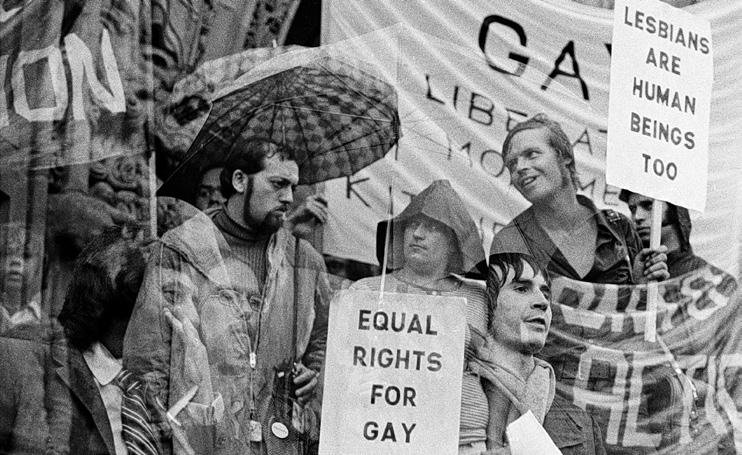
The ArQuives are open to the public and maintain a research library, international research files and a international collection of queer and trans periodicals.
“We are definitely one of the world’s largest independent 2SLGBTQIA+ archives,” says Bickford. “While some archives are in partnerships with universities, what makes us different is that community members can come in, and researchers, teachers, and filmmakers can come and visit and use the resources here for free.
VIEW ARTICLES, BOOKS, POSTERS AND MORE
ArQuives visitors can see primary source materials and get their hands on articles, books, posters, buttons and t-shirts. “We have a full library with thousands of artifacts, it’s a pretty extensive collection,” says Bickford,
explaining that as a community collection they’ve had a lot of donations over the years. Collections are also being digitized all the time with the hope of making the materials accessible to a wider audience.
The ArQuives have worked with local Ontario teachers, schools and school boards over the past 15 years and have seen the demand and need for resources growing across the country. “Teachers have often reached out to us asking for materials to help plan lessons, and we wanted to create something that teachers outside of this province can also use,” says Bickford, adding that they also did focus groups and surveys to gauge what teachers are really needing, including getting feedback from Manitoba teachers.
ARQUIVES LESSON PLANS
FOR MANITOBA CURRICULUM
Out of this planning the ArQuives has created a mini unit for educators, including a Manitoba curriculum version. Entitled “Stories Matter” the collection of lessons can be used for either an English Language Arts or Social Studies secondary school course in Manitoba. The unit contains three 75-minute lessons on language related to queerness, learning about 2SLGBTQIA+ his/ her/hirstories, and covering 2SLGBTQIA+ icons.
“We wanted to build something into the curriculum, so it wasn’t just an add-on for pride month,” says Bickford. “We want to encourage deeper conversations.”
12 THE MB TEACHER | SPRING 2022
The lessons in the unit are independent from each other and include links to videos and resources. Teachers can teach the entire unit at once or split it up throughout the year.
The ArQuives contain a disclaimer about language, citing that because their records go back to the 1850s, many items in their collection may be considered offensive or unacceptable by today’s standards. However, preserving the language of each individual artifact reflects how 2SLGBTQIA+ individuals and communities defined themselves and provides uncensored depictions of darker chapters in Canadian history.
“This is one of the reasons it’s easiest to start with high school students because they’re a little bit more mature and it’s easier for them to understand the context of where some of this stuff comes from.”
Bickford says she finds it interesting how the narratives have changed over the years.
“One of my favorite 2SLGBTQIA+ films I’ve seen is called the Fruit Machine. It’s about the purge of homosexuals from the Canadian civil service and federal government throughout the ‘80’s. They were subjected to a polygraph type of test to determine if they were homosexual. They were outed from their jobs and
THE MTS 2STLGBQIA+ AD HOC COMMITTEE RELEASES RECOMMENDATION REPORT
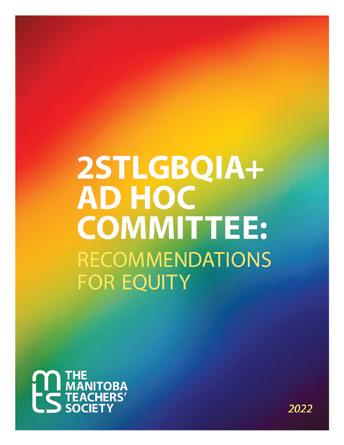
Thirty-five recommendations for equity will be presented by the MTS 2STLGBQIA+ ad hoc committee at the 2022 MTS Provincial Council meeting, following a year long investigation on barriers faced by 2STLGBQIA+ members in their engagement with the Society, as well as their locals and schools.
The resolution to create the MTS 2STLGBQIA+ Ad Hoc Committee came out of the 2021 MTS Annual Provincial Council meeting, as part of the work presented by the Equity and Social Justice standing committee.
“We felt as a committee we could speak individually to what some of these barriers were, but we knew we weren’t getting all the stories,” says Lindsay Brown (they/them), chair of the ad hoc committee.
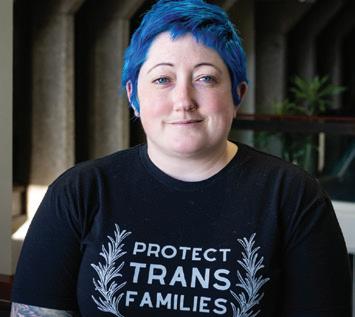
The group was composed of members from across the province, and across different identity groups. The first meeting was spent talking about their own experiences, as well as different issues they were hearing about in their schools. Guest speaker Dr. Robert Mizzi from the University of Manitoba spoke to the committee about his own research around queer and inclusive education, while Chris Campbell, PhD student and one of the lead researchers on the ‘Every Teacher’ project which was done with MTS in 2015,
spoke about some of the recommendations in that document.
“We started developing some of those recommendations and realized we wanted more outreach, so we put out a call for a virtual consultation which happened in January,” says Brown. Members across the province attended the Zoom meeting to look at the drafted recommendations and share their input.
“We had some great discussions and feedback,” says Brown. “After the virtual meeting we had people sticking around, asking how they can get involved further, and that was really affirming that our work is important. In some of the comments people were saying that they had never seen
communities, had their lives destroyed.”
A group of veterans from that era attended the film screening in Ottawa in 2018. “There was not a dry eye in the house,” says Bickford. “It was shocking what they were put through. I think a lot of people don’t know that this kind of stuff went on in Canada. This is why it’s so important to teach this stuff.”
Teachers can access the ArQuives mini unit at https://www.mbteach.org/ mtscms/2022/04/25/the-arquiveslesson-plans/ or contact the ArQuives at queries@arquives.ca for any research related queries.
themselves represented before, and how this made them feel that their union cares about them.”
Though the recommendations are focused on queer and trans members, Brown says that equity work will benefit all members, even those not part of the community.
“We’d love to see some of the recommendations operationalized and see this become part of the fabric of what we do as a union. Ultimately, we’d love to see more of the queer and trans folk get involved in some of the leadership roles within the union. We want to send the message to our members that we want to support this population of our membership and that they’re important and valued.”
SPRING 2022 | THE MB TEACHER 13
GENDER DIVERSITY IN CANADA, ONE STUDENT VOICE AT A TIME
Perspectives
By Wes Delve Program Officer, International and Social Justice Program Canadian Teachers’ Federation
How do we define gender today? Well, there exists a wide variety of genders beyond the boy/man – girl/woman binary. And even though here in Canada great strides have been made to uphold the rights of those who experience, for example, feelings of attraction in all its forms beyond the heterosexual, those strides have yet to be made where gender identity and gender expression are concerned.
This is why the Canadian Teachers’ Federation’s (CTF/FCE) new resource, Affirming Gender Diversity, the latest in the series of Student Voice booklets, is so important. Not only does the booklet support teachers in raising awareness and addressing questions from students around the diversity of gender, as well as social concepts such as cisnormativity, cissexism and transphobia, it does so through the students’ own experiences.
Past President CTF/FCE Shelley Morse felt strongly about creating a booklet on gender diversity.
“When I became chair of the CTF/FCE Advisory Committee on Diversity and Human Rights, I felt this topic would fill a much-needed gap in our classrooms,” says Morse. “The work just took off from there.”
As a program officer with responsibilities for the CTF/FCE Social Justice Program, Wes Delve thought he already knew quite a bit about the issues, but quickly recognized that his initial expectations were but an inkling of what awaited him.
He came to discover that he
understood very little about the topic, and the realization was disconcerting and humbling. On a deeper level still, and even more disturbing, lay the harsh realities and the painful, daily truths lived by gender diverse people in Canada, a country renowned for its equitable treatment of all citizens. As he learned more about these truths, Wes was disheartened and somewhat embarrassed.
When he began reading the submissions received from Canadian students, in response to the focus questions the CTF/FCE developed and which had been implemented by volunteer teachers in their classrooms, Wes was buoyed by the candour, the energy, the knowledge and the wisdom they contained.
VOICES OF STUDENTS FORM CONTENT
“Truth be told, I teared up several times, and enthusiastically shared occasional gems with others involved in the project,” he explains. “I came to realize that this generation of Canadian students is not only blessed with insights which far surpass what I understood when I was their age, but it is well equipped and ready to fight against the discrimination it sees in the world around them.”
The voices of students form the content from which lesson plans were developed. And those lesson plans are essential to bringing the content alive in the classroom. They help teachers encourage students to discuss important issues, to challenge the
status quo societal response, and to take action to increase awareness among the school population and the local community.
“With a lesson plan in hand,” Morse indicates, “our members are supported to tackle the issue of affirming gender diversity without having to start from scratch. At the same time, the lesson plans offer a starting point from which educators can easily adapt the material to the needs of their students.”
Affirming Gender Diversity, developed by educators for educators—including MTS Provincial Executive member-at-large Catherine Hart—provides multiple entry points to facilitate work with students.
The Advisory Committee on Diversity and Human Rights, of which Catherine was a part, played a crucial role in bringing the classroom teacher perspective to the work.
“It was such a privilege to collaborate with people who bring a wealth of experience and perspectives on identity and intersectionality,” says Hart. “Affirming Gender Diversity shows students’ experiences and understanding around gender and sexuality in their own words, across grade levels. It’s a great starting point for discussion with students, but also with adults as we reflect on the changes needed in our policies and practices.”
Wes is grateful to have been immersed in the creation of the booklet and for the many individuals who accompanied him on the journey. “I am happier still that we released this booklet on July 14, 2021, the International Non-Binary People’s
14 THE MB TEACHER | SPRING 2022
Based on the CTF/FCE
article
5STUDENT VOICE BOOKLETS ARE:
• POVERTY, WHAT IS IT? (2014)
• MENTAL HEALTH STIGMA: CHALLENGING IT TOGETHER! (2016)
• TRUTH AND RECONCILIATION: WHAT IS IT ABOUT? (2016)
• L’INSÉCURITÉ LINGUISTIQUE: COMMENT LA VIVONS-NOUS? (2019)
• AFFIRMING GENDER DIVERSITY (2021)
Day, and that this new resource was in Canadian classrooms in time for Canada’s national Gender Equality Week, which takes place annually during the third full week of September.”
STUDENTS SPEAK OUT, INSPIRE AND DEFEND
This generation of students is indeed prepared to speak out, to inspire and to defend. And it is our job, as educators who have the privilege of teaching and learning alongside budding advocates for gender equality, to inspire them in return to foster safe environments for them to ask questions, engage in open and honest discussions, and encourage them to raise their voices to interrupt and challenge the injustices they encounter in the world around them.
Even now, a teaching and learning resource as rich as this does not begin to do justice to the suffering experienced by some of our most oppressed and marginalized people, or to the change that needs to happen when it comes to the acceptance and inclusion of gender diverse individuals.
It is hoped that this resource will rally all educators to engage in this work—work that is vital to including, valuing, and lifting up individuals of all genders in our society.

You can find Booklet #5: Affirming Gender Diversity, and its lesson plans at Initiatives - Imagineaction imagine-action.ca or for more information contact: info@imagine-action.ca.
AFFIRMING GENDER DIVERSITY SHOWS STUDENTS’ EXPERIENCES AND UNDERSTANDING AROUND GENDER AND SEXUALITY IN THEIR OWN WORDS, ACROSS GRADE LEVELS. IT’S A GREAT STARTING POINT FOR DISCUSSION WITH STUDENTS, BUT ALSO WITH ADULTS AS WE REFLECT ON THE CHANGES NEEDED IN OUR POLICIES AND PRACTICES.
CATHERINE HART
PROVINCIAL EXECUTIVE MEMBER-AT-LARGE THE MANITOBA TEACHERS’ SOCIETY
SPRING 2022 | THE MB TEACHER 15
GROWING THE INCLUSIVE CLASSROOM: MICHELLE JEAN-PAUL ON DISCOMFORT, HUMILITY, AND THE COMMITMENT THAT DRIVES SYSTEMIC CHANGE
By Anne Bennett, MTS Staff
She’s still teaching, but Jean-Paul’s classroom is bigger now, as she carves pathways for progress on diversity, inclusion and anti-racism services in the Louis Riel School Division.
From the time she was a child, there was never much doubt that Michelle Jean-Paul would become a teacher. Singularly focused, she’d gather her siblings and neighbourhood friends together to review times tables and lessons she’d planned just for them.
Jean-Paul credits her father, a teacher in Haiti and Canada, for instilling in her a love of education and its role in the creation of a vibrant, compassionate and just society.
“Teaching,” she said in a 2018 Manitoba Teachers’ Society ad campaign, “is what I was born to do.”
Last January, Jean-Paul left her role as principal of École Templeton in Seven Oaks to advance the Louis Riel School Division’s work on diversity,
equity, inclusion and anti-racism services. While she’s still teaching, her classroom looks different today than it has throughout her career.
For one thing, it’s bigger. A lot bigger.
EXPANDING DIALOGUE AROUND ISSUES OF EQUITY
“I’ve gone from a classroom with dozens of students, to a school of hundreds, to a division of thousands. It’s really an opportunity to expand the important dialogue around issues of equity. It can be easy to feel like you’re always the one sounding the alarm on certain issues, which can silence you sometimes. But here, part of my role is to offer those critiques, which feels very empowering.”
She dove into her new role fueled by the potential to put into practice all she’d learned throughout her career.
“Issues around diversity, equity and inclusion have informed my educational philosophy since I was a teacher candidate. As a principal, I supported colleagues and community in a variety of ways, but my first responsibility was always to my own school community. This role really gives me the opportunity to hone in on this work in very intentional ways. It gives me the space and time to commit to the work.”
The work, she says, is essentially relational, and trying to create connections in the midst of a pandemic was no easy feat. Even so, virtual meetings with colleagues have led to meaningful dialogue needed to build trust.

16 THE MB TEACHER | SPRING 2022
“Beginning the work at this time certainly limited the ways in which I could connect, but it also gave me the opportunity to be more intentional in the relationships that I’m building. These conversations helped me develop a great sense of the commitment folks have to this division and to creating an even stronger sense of belonging among members of our community.”
In 2009, Jean-Paul founded the Educators of Colour Network (EoCN). The group meets—virtually, since COVID— to share perspectives, experiences and resources. The intent is to build belonging and peer support among educators doing the often-exhausting work of advancing change to deeply entrenched systems.
“Hearing the stories of internationally educated teachers and other racialized educators over the past 13 years has given me a better understanding of how systemic some of the issues—and our subsequent responses—must be.”
Originally created as a space for Black educators, other minoritized teachers soon saw the EoCN’s potential. Membership continues to expand, as do opportunities to learn and network in support of diverse representation and perspectives in teaching.

Establishing those connections is critical to the overall goal of manifesting change in the classroom and the larger school community. To Jean-Paul, that impact can take
many forms, including the building of teacher capacity to engage students, colleagues and community in critical conversations and learning.
BRINGING COMMUNITY INTO THE CLASSROOM
“I’m really encouraged by the number of people who have already sought me out to talk through an issue or deepen their understanding. My title and my identity seem to be an invitation of sorts for people to have the tough conversations with me.”
Success, she says, looks like increased diverse representation in lessons, decentring dominant ideologies, bringing community into the classroom to learn from and walk beside people to
SPRING 2022 | THE MB TEACHER 17
Michelle Jean-Paul speaks to students at Collège Jeanne-Sauvé
PHOTO BY MIKAELA MACKENZIE / WINNIPEG FREE PRESS
develop allyship.
“It also looks like teachers making mistakes along the way, and using those opportunities to grow and do better. And to do so knowing they have the support of their division as they work to create more inclusive spaces within their classrooms.”
For teachers aiming to advance equity and social justice in their classrooms today, look no further than your students and their families for support, says Jean-Paul.
“They are your most valuable “resource”. Build strong relationships with them, extend the invitation continuously, and approach your work with humility. You will make mistakes along the way, but that is all a part of learning. It is how you respond to those mistakes that will demonstrate your commitment to equity.”
With colleagues demonstrating no shortage of enthusiasm for the work, developing a plan of action and measurements of success become key.
“What I hope to see is a strong response from school communities that show us we’re making gains and better representing diverse groups that live here. Louis Riel does a phenomenal job of data collection, so whether we’re looking at qualitative or quantitative measurement, growth or success will be found in more stories that celebrate belonging.”
ROLE REPLICATED IN OTHER SCHOOL DIVISIONS
Jean-Paul would like to see her role replicated in other school divisions. A genuine desire for change, however, coupled with acceptance of the messiness inherent in tackling long-held perceptions and entrenched systems, are non-negotiable.
“This type of role is essential, but it must be authentic and purposeful. I would absolutely love to see more school divisions creating similar roles, but it needs to be more than just a tokenistic act. Infrastructure to support the work in deep and meaningful ways, and a willingness from leadership to model discomfort and humility are required to create true systemic change.”
And for systemic change to occur, it must be rooted in a commitment to shared priorities.
“One of the things that attracted me to the job was the understanding that this is not the work of one individual or department. It’s the work of everyone across the entire division. There will always be resistance to any kind of change; I think that’s human nature. But naming forms of oppression and openly engaging in discussions about it as a division is how we move forward in our understanding. We need to be ready to wade through the messiness of this important work.”
While it wasn’t easy to leave her École Templeton school community, Jean-Paul sees her new role as a natural progression of work that’s been foundational to her career.

“I am grateful for everything I learned both with and from my students and colleagues. There are so many great people out there who share the vision of creating spaces of belonging within our
schools—particularly those the school system has oppressed, ignored and underserved for generations. And on my last day, my students reminded me of the responsibility I have in this role. They have been my best teachers.”
HUMBLED AND REFLECTIVE ON NEW APPOINTMENT
The reaction to her appointment both within the division and beyond has left her both humbled, and reflective.
“It’s made me feel proud of how I’ve built on the legacy that my dad and his generation of Black educators set for me. They are the ones I modeled myself after as an educator. The overwhelmingly positive response I’ve received demonstrates how willing and open people are to this work—they understand its importance and the urgency behind it. They’re eager to contribute to positive change within the school system. And that is the power of education.”
18 THE MB TEACHER | SPRING 2022
FOLLOW
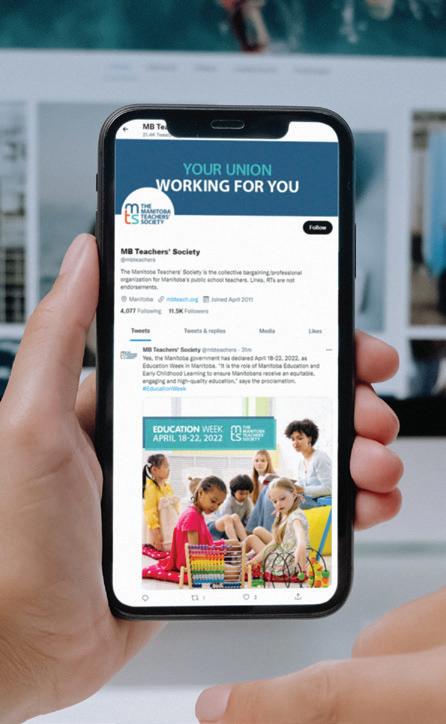


SPRING 2022 | THE MB TEACHER 19 MORE CONFIDENCE. MORE QUESTIONS. SCHOOL IS WHERE KIDS GROW. manitobateachers mbteachers mbteachers PLAYSAFE: Don’t Let It Happen to You The War Amps “kids-to-kids” safety video, featuring stories from young amputees who have lost limbs in accidents, delivers the hard-hitting but positive message: “Spot the danger before you play!” Adam Rebecca Visit waramps.ca/playsafe for the video and safety resources.
US ON SOCIAL MEDIA manitobateachers mbteachers mbteachers Make sure our news follows you by following us on social media. You’ll find fun, inspiration and collaboration with colleagues who’d love to share with you.
EDUCATION PORTFOLIO GETS A FAMILIAR FACE
By Samantha Turenne, MTS Staff
With the growing challenges in the K-12 public education system and the many opportunities for positive change, the appointment of Wayne Ewasko, MLA for Lac du Bonnet, a former teacher, as Minister of Education and Early Childhood Learning is a welcomed move.
“It has been almost a decade since a public school teacher was at the helm of Manitoba’s education department,” said MTS President James Beford. “Teachers like to see teachers in this role because it usually means, at the very least, that there is an understanding of what works well and where there is room for improvement.”
Ewasko started off his career in education as an educational assistant working with students with additional needs in the Sunrise School Division, following completion of his Bachelor of Education degree.
“It was my EA position that contributed to me being in this chair today because it opened up the door for me by working with kids with special needs,” said Ewasko. “I worked 12 of my 17 years in student services, either as a guidance counselor or as a behavior support teacher.”
EXPERIENCE IN THE CLASSROOM BIGGEST
STRENGTH TO ROLE
He also taught Grades 7 and 8 as well as pre-calculus at the high school level, and points to his experience in classrooms and schools as one of the biggest strengths he brings to this role.
“I've been there,” he said. “I've seen many different sides of the educational world and I think just knowing, to a certain degree, what people have gone through or are going through especially over the last two years is extremely valuable.”
When Ewasko decided to run for MLA in 2011, the education minister post was
something he had his sights set on.
“I left teaching when I was loving it,” he said. “Running for MLA was about taking the opportunity to go out of the school, which was about 700 students, and then raise it up a notch.”
As education minister, Ewasko supports a system of more than 200,000 students and 36,000 school staff. The education portfolio was also expanded to include early childhood learning, a move that the minister applauds.
“This move was absolutely spot on,” he said. “The synergy between the two levels definitely hit the mark and I know that there is a lot of good work that we're all going to do together.”
Ewasko has kept in touch with education colleagues over the years and continues to be amazed by their abilities.
“They can adapt and pivot and then come up with great ideas to motivate and challenge students to learn. This has been proven especially during the pandemic,” he said. “These are the people who are seeing our kids for the majority of the day, and we know that the past couple years have been very stressful on all of them, but they continue to excel.”
DIVERSITY, EQUITY AND INCLUSION
Turning the conversation to diversity, equity and inclusion Ewasko agrees that it is important for students to see themselves reflected in their teachers.
“I had the pleasure of being selected
as an Aboriginal Academic Achievement leader for the school that I taught at. I was also on the Aboriginal Education Committee for the school division,” he said. “Well as you can see, I am Polish-UkrainianCzechoslovakian.”
Ewasko said that it was his “thirst for knowledge about things that I did not know” that drove him to get immersed in Indigenous education.
“We need to keep moving forward, in this respect, because our Indigenous population is growing,” he said.
In Manitoba, there is limited student and teacher disaggregated data available on equity-seeking groups, however, according to the 2021 MTS membership poll, fewer than one in eight members (12%) identify as being of Indigenous ancestry. This is an increase of four points from last year, but still below the total number of Indigenous individuals in Manitoba’s general population (17%).
There is even less representation for People of Colour (POC), with less than one in 10 (9%) of MTS members identifying as being in a visible minority, about half the total number of individuals from this group in the general population (19%) and unchanged since 2020.
In the case of sexual or gender minority, MTS members are higher than in the general population (4%). One in 14 (7%) MTS members identify as being in a sexual or gender minority, up two points since 2020.
“I know that part of the workforce strategy on recruitment and retention of
20 THE MB TEACHER | SPRING 2022
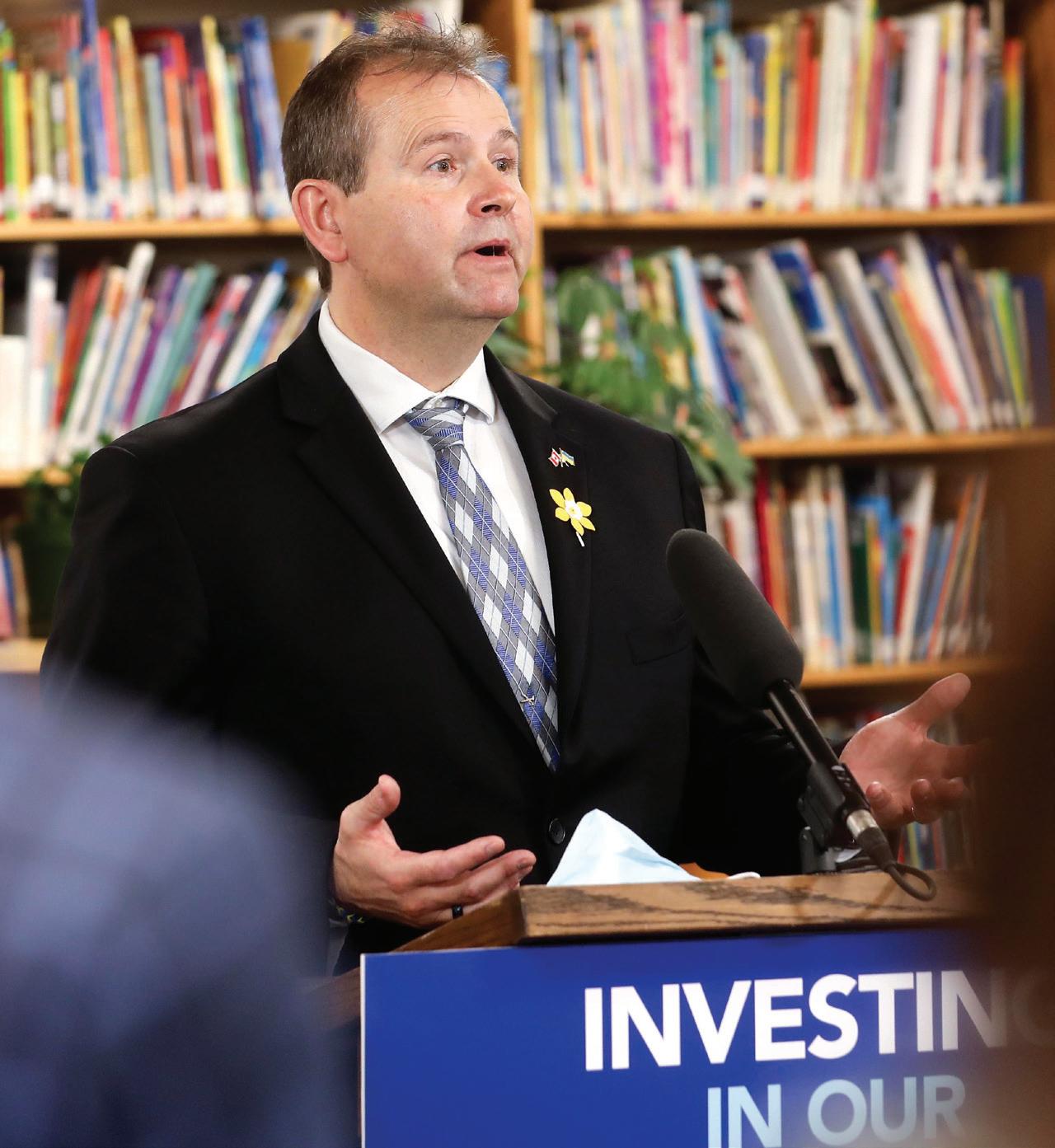
SPRING 2022 | THE MB TEACHER 21
PHOTO BY RUTH BONNEVILLE / WINNIPEG FREE PRESS
school staff, typically in rural and northern regions, is prioritizing reaching French and Indigenous language educators,” he said. “We're looking for some opportunities on how we also remove some of those barriers for internationally educated teachers.”
He said that the education department is working with the Université de SaintBoniface on permanently expanding its Bachelor of Education degree program to help address the French language teacher shortage in Manitoba.
“As a rural teacher, I know that this has been a challenge for many years. I think this is going to help alleviate some of the pressures,” he said. “This is definitely not going to be a quick fix, but I think it's one of the things where we're planting the tree that will bear good fruit for years and years to come.”
Being immersed in the public education system for 17 years, and having kids go through the system, Ewasko acknowledges that supports can vary depending on where students live.
“As a teacher, I heard rumblings and

grumblings about funding inequities before I even decided to get into politics,” he said. “The funding model is now being reviewed for the first time in almost 20 years. We have begun consultations with key education stakeholders and school divisions, and I am ecstatic that MTS is part of this group because you have a huge voice.”
He said that the new model will be introduced for the 2023/24 school year and will “improve equity and accountability as well as provide some flexibility to school leaders to really take a good look at what they need locally.”
Ewasko is looking forward to working with education partners and getting out to speak with students, teachers and school staff.
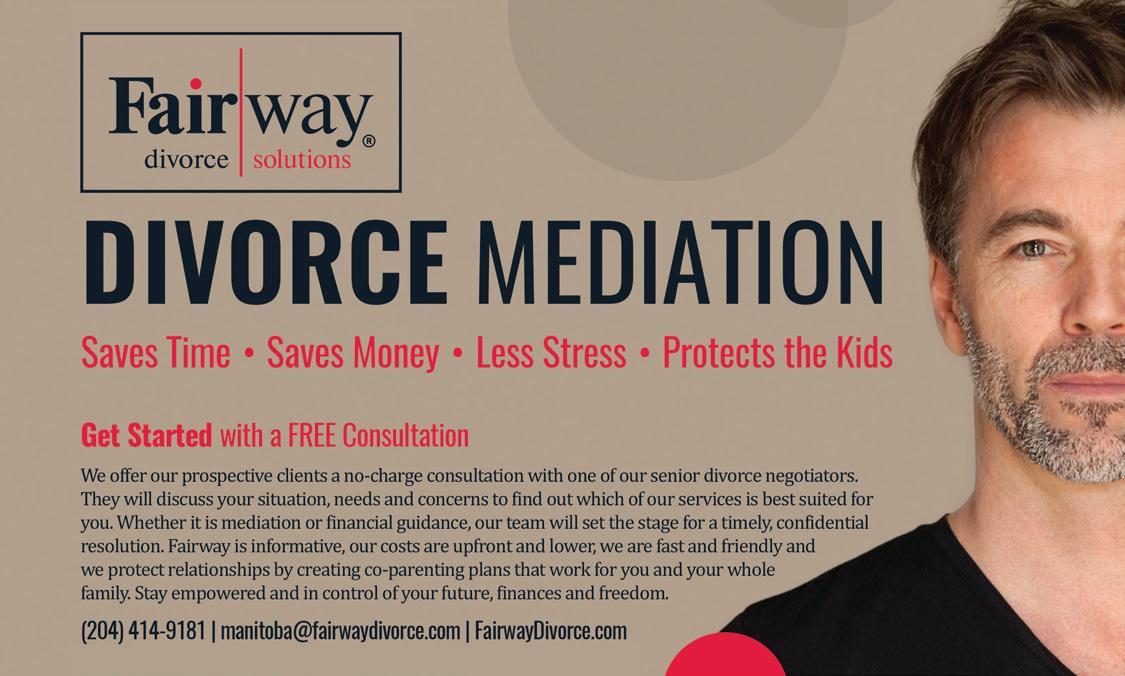
“My door is always open,” he said. “I want to get out there and hear about the challenges and the good things that are happening within our school system.”
He said that an excellent school is one where the teacher and the staff are supported and the students are engaged, excited and challenged to reach their full potential and do their best.
“It is also important that schools are very accessible and have a safe and healthy environment,” he said.
When asked to share any final thoughts or comments with Manitoba teachers, Ewasko had two words, “thank you.”
22 THE MB TEACHER | SPRING 2022
Bicycle Mechanic and Riding


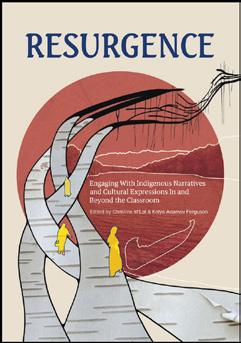

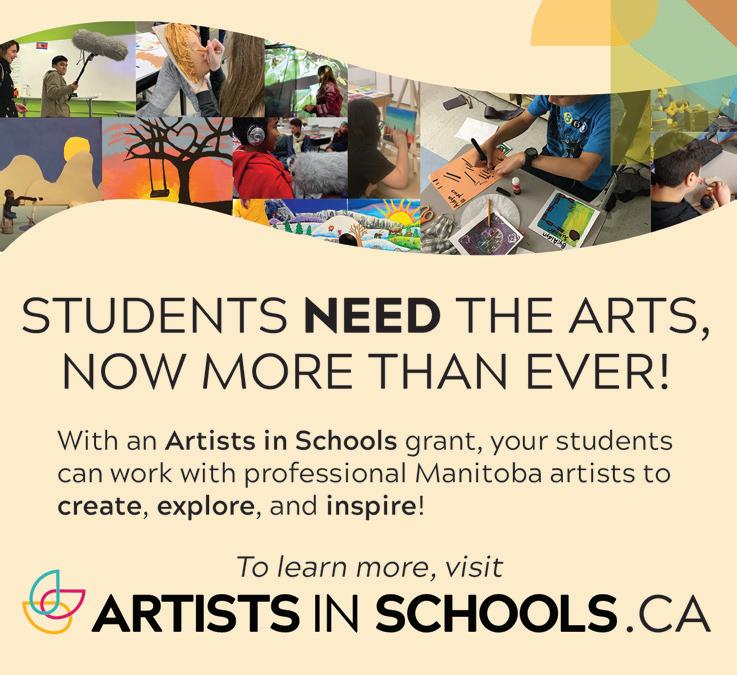


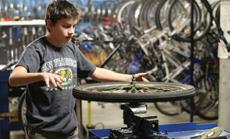
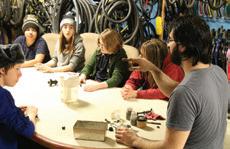

SPRING 2022 | THE MB TEACHER 23
Programs For whole classrooms, entire schools, or special groups needing a hands-on experience, WRENCH delivers engaging, quality, and professional workshops in bicycle mechanics and riding. Contact us to craft your unique experience or take advantage of our ready-made options. visit us at thewrench.ca For more information, please contact: Gregory Allan, Education Coordinator c. (204) 588-4598 e. gregory@thewrench.ca EMPOWERING Books to Shape the Future of Education EDUCATORS
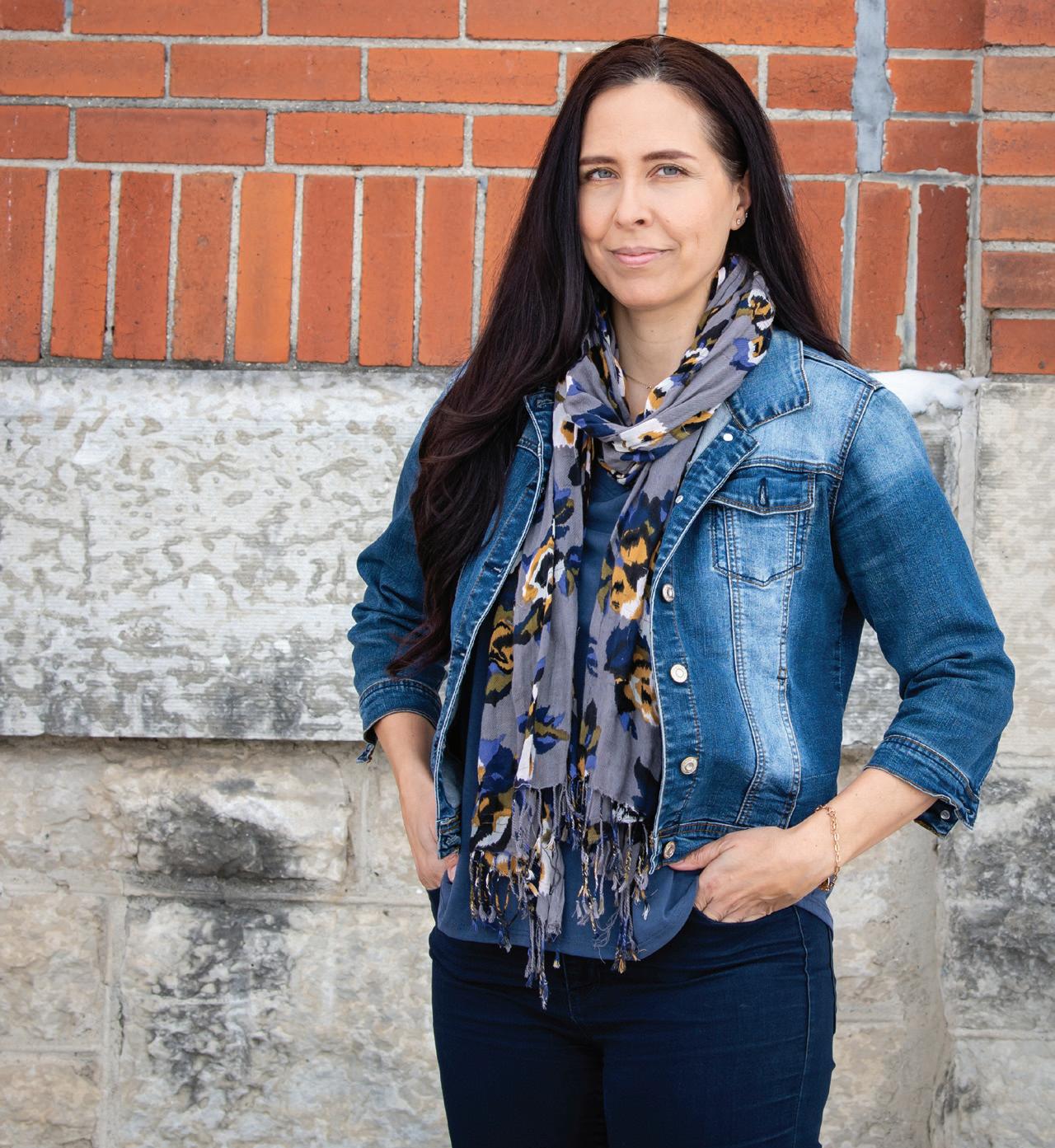
24 THE MB TEACHER | SPRING 2022
SO MANY GREAT THINGS HAPPEN WHEN WE’RE ENJOYING THE PROCESS. WE BECOME LOST IN THE ACT OF ARTMAKING, WE GET SO CAUGHT UP IN THE MOMENT THAT OUR FOCUS IS HEIGHTENED ONLY ON WHAT WE’RE DOING AND CREATING AT THAT TIME AND WE'RE NOT THINKING ABOUT ANYTHING ELSE. THIS IS WHERE THE MAGIC HAPPENS. THE ARTWORK BECOMES HIGHLY INDIVIDUALIZED, AND THE PROCESS CAN BE TRANSFORMATIVE.
THE THERAPEUTIC BENEFITS OF ARTMAKING
 By Christine Deckert, LRTA
By Christine Deckert, LRTA
The guiding question for my teaching practice after March 2020 was, ‘how can I best help my students during this incredibly challenging time?’ I‘ve always been aware of the therapeutic benefits of artmaking and the positive effect it has had on my own life during stressful times. It wasn’t until the pandemic that I realized how essential it was as a collective to prioritize mental health and wellbeing, while sharing our tools with others.
When we engage in creative activities not only do we nurture our true selves, but we increase dopamine levels and reduce cortisol as we lose ourselves in the process of exploration and discovery. By creating new experiences and possibilities through artmaking we expand our awareness and develop new insight. For me, creating art can be a highly meditative process as it slows down the overactive mind and relaxes the nervous system.
As an artist, my ‘go to’ approach when I need to calm my mind, tune out the world, gain clarity, or center myself is to draw, paint, collage and journal—if you combine all of these you get art journaling. It’s a natural, heathy, and cost-effective way to access the therapeutic benefits of artmaking. Tapping into our creative side is an invaluable resource in times of need or when other avenues are restricted or limited. Art journaling can be used by students at home to express themselves more deeply and privately if they’re looking for an outlet to release their thoughts and feelings through combined writing and imagery. At school we keep it more general since the artwork is viewed by other classmates.
Teaching during a pandemic has taught me to be ‘lighter’ in my approach when teaching technique and content. I try to place more emphasis on enjoying the process, experimenting, and having fun. I know that technique and skill development will follow and I don’t want to add
SPRING 2022 | THE MB TEACHER 25
on to the stress or anxiety my students may already be suffering from. By removing the added pressure of focusing on the end product, students become more willing to express themselves without fear of judgment or failure.
For the art project I am going to share, if a student is struggling with how or where to start, a good approach is to tell them to start by scribbling or doodling because that eliminates excuses and fear of failure, since everyone can scribble, right? In this project we use mixed media and all forms of mark making are acceptable. I repeatedly tell students that “mistakes” (an unintentional drip of paint, a marker line they can't erase, etc.,) serve as steppingstones for new discoveries, and one mark leads to the next. Helping students overcome any barrier here will go a long way! They'll feel safe and free to create which helps foster a sense of wonder and possibility, while lowering stress in the process.
So many great things happen when we’re enjoying the process. We become lost in the act of artmaking, we get so caught up in the moment that our focus is heightened only on what we’re doing and creating at that time and we're not thinking about anything else. This is where the magic happens. The artwork becomes highly individualized, and the process can be transformative. When we give students the freedom to make their own discoveries, they learn how to trust themselves and create in new and innovative ways. They develop problem
solving skills, develop self-esteem and enhance self-awareness.
A great art project that supports this approach is art journaling. It’s appropriate for all ages, it’s enjoyable, experimental, personal, easily adaptable, and affordable. The focus here is to have fun, relieve stress, and enjoy the process of ‘play’. This project provides the learner with plenty of freedom to experiment with the supplies and choose which items they want to incorporate into their work that speak to them, using the supplies to inspire the next step. I encourage my students to go with the flow throughout the lesson as it teaches them how to listen to their intuitive guidance by allowing one decision (selecting a quote, a colour, using a sticker, etc.) to lead them to the next. The approach should be kept organic and fluid, allowing student imagination to lead the way!

This lesson can be done in any space, using any materials available, at any skill and grade level. To make the lesson more playful and fun I filled several bins with a variety of random supplies (printed quotes, poetry, inspirational words, stickers, felt, printed music sheets, stamps, ink pads, old playing cards, stencils, buttons, etc.) and placed the bins at the front of the room. This part of the project was highly sensory and felt like a treasure hunt as students eagerly searched through the bins, digging around and selecting items they wanted to use for their art, items that ’spoke’ to them and that they also used as inspiration. I recommend
LESSON PLANS
ACCORDION ART JOURNAL
DAY 1: Have students divide watercolour paper into eight sections by folding it in half and then quarters. In each square the students use a different watercolour technique. Provide students with a demo prior to them starting (I like to write the name of the technique in each box the students don't write it on theirs). Some super fun techniques are; wet-on-wet, splatter, wax resist, saran wrap, masking tape, salt, and gradient. I always leave the last box for the students to experiment with.
DAY 2: Students cut the watercolour paper down the center then tape both ends together on the back using masking tape. Fold the paper into an accordion style book. Imperfect folding is ok, it adds character! Tape a piece of string or ribbon onto the back page to wrap around the book to hold together. On each watercolour section the students add images and text by drawing, colouring, doodling, cutting and gluing printed text and words, using stamps, writing poetry, quotes, writing their thoughts, etc.
having a few students at each bin at a time and taking turns gathering items.
I love to repurpose recycling and here are a few ideas you may choose to incorporate: Make your own stamps by gluing foam shapes onto wood blocks or juice lids, use styrofoam food trays to create stencils, fruit/ veggie carousels to organize the supplies, avocado bags to create texture with acrylic paint, plastic lids to trace and create circles, old books and magazines to cut up words and pictures, old stamps, playing cards, any scrapbooking or collage items, plastic forks to create texture by dragging through acrylic paint, bubble wrap to create texture with paint or marker, yogurt containers to hold water and lids to use as paint palettes, etc. You could send an email to staff asking for some supplies to help build your collection. I was given a lot of great stuff and got lucky when a few teachers were purging crafting and scrapbooking supplies from home.
I incorporated watercolour techniques into this art journaling project and presented it in an accordion style book because it looks so darn cool. The watercolour will serve as the background and words and pictures are added on top. There are countless ways to art journal so if you don't have watercolour paper just use regular paper and whatever supplies you have on hand! If you want to skip the paint entirely, you can take a more traditional approach using hand drawn or collage imagery and words on paper. The options here are endless. Use what you have, and have fun!
26 THE MB TEACHER | SPRING 2022
MIXED-MEDIA


























































Member & Family Assistance Program (MFAP) We can help. Free and confidential support for eligible members and their families. • Relationships and Couples • Family and Parenting • Stress • Anxiety • Depression • Substance Use • Legal and Financial • Grief and Bereavement • Career Coaching • Behavioural Management • Diet and Nutrition • Work-Related Stress • Bullying and Harassment • Crisis and Trauma HumanaCare’s supports and services can assist in the following areas: 1-800-661-8193 24 HOURS A DAY ANYWHERE IN NORTH AMERICA www.humanacare.com/mts Check your MTS email dated December 15 for the access code to set up your personal HumanaCare profile.
CARE FOR ALL IN EDUCATION: MAKING EDUCATORS’ MENTAL HEALTH A PRIORITY
By Cynthia Thoroski Canadian Mental Health Association
A recent University of Winnipeg study on pandemic-induced burnout in Canadian educators showed Manitoba’s teachers are approaching levels of emotional fatigue and mental exhaustion at rates nearly 20 per cent higher than across the rest of Canada.
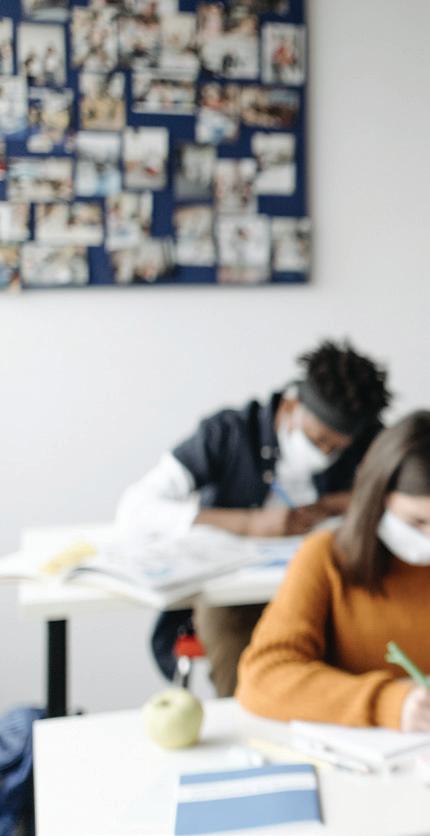
Based on that study, the Canadian Mental Health Association (CMHA) Manitoba and Winnipeg, received provincial government funding to launch the Care for All in Education initiative last November.
Many professions making up today’s educational sector face increased stress, anxiety and emotional fatigue courtesy of the pandemic, and teachers are no exception.
Marion Cooper, CEO of CMHA, Manitoba and Winnipeg, says those working in caregiving sectors like education often put the needs of others before themselves. She says the site is getting more and more traffic, however, ongoing communication about Care for All in Education—a demonstration project that
will carry on until the end of June, 2022— will be essential so that it’s top of mind when educators need it.
“Folks in education and healthcare are often so busy focusing on supporting others that their own mental health becomes less of a priority, or feels like just one more thing to do.”
FASTER ACCESS TO MENTAL HEALTH SUPPORTS
Designed to help education sector employees get faster access to mental health supports, Care for All in Education delivers access to a mental health web portal customized to the needs of education staff, a team of wellness support specialists to help navigate access to mental health resources and a
host of mental health/wellness workshops customized to various profession groups across the K to 12 school setting, (teachers, caretakers, educational assistants, clerical staff, etc.).
Ongoing trends seen in calls and emails to Wellness Support Specialists are showing that staff are appreciative of faster access to mental health programming within their community, locating information to support their own mental health and that of family members, guidance in developing long-term wellness plans and so much more.
As the initiative evolves, CMHA’s Care for All in Education team is continually adding new online resources to the web portal in response to trends in calls and emails from education staff and the
28 THE MB TEACHER | SPRING 2022
advice of a diverse sector-wide working group, which includes The Manitoba Teachers’ Society.
Customized presentations (both inperson and virtual) are also being delivered by wellness specialists to schools across the province to demonstrate how to access resources on the web portal and through outreach to the wellness support team.
Future steps for the evolution of resources include a French language version of the web portal and the development of wellness workshops for education sector staff. To access the web portal visit careforallineducation.com . To contact the wellness support specialist team (available 8 am to 8 pm, Monday to Friday) call 1-877-602-1660 or email info@careforallineducation.com.
SHARE YOUR VOICE FOR EDUCATION
After presenting at the Canadian Society for the Study of Education and the American Educational Research Association conferences, the University of Winnipeg research team of Laura Sokal, Lesley Eblie Trudel, and Jeff Babb continue to work with CMHA and partners within the education sector to investigate and demonstrate the value of the resources offered through the Care for All in Education initiative.
The UW team is collecting anonymous 12 to 15-minute, online surveys from education employees who access CMHA services. Survey participants can enter a draw for one of three $100 prizes. Survey participants will have the option to complete the survey and/or conduct short
interviews again in three months. If you would like to participate, more information and the anonymous online survey can be found in the ABOUT US section of the Care for All in Education website careforallineducation.com
PUTTING RESEARCH INTO PRACTICE
Data collected will be used to investigate possible changes resulting from contact and involvement with CMHA mental health and wellness resources. The research team is thoroughly enjoying collaboration with their partners throughout the Manitoba education sector, as it allows them to see their research put into practice with those who support the educational success of Manitoba students.

SPRING 2022 | THE MB TEACHER 29
THE PRINCIPAL OF THE THING: REX FERGUSON-BAIRD AND LISA ALBRECHT TALK ABOUT THE POWER OF STARTING, STAYING, AND THE NEXT NORMAL
By Anne Bennett, MTS Staff
Both educators cite the essential role of team wellness in getting through the day not only effectively, but optimally. It’s easy to become depleted in an environment where the foundation is in continual flux.
It’s safe to say that Lisa Albrecht didn’t know what she was in for when she became vice principal at Winnipeg’s École MarieAnne-Gaboury in 2020. The first-time school leader was immediately plunged into pandemic mode, adapting to a reality that morphed by the day.
She took it in stride, however, citing adaptability, colleague connection, and a deep-seated love of the classroom as her primary weapons against mass destruction.
“I anticipated the role of school leader to come with demands of time and energy—perhaps as it was when I was a classroom or student services teacher— but with extended hours”, she laughs. “I also expected that the role would require more (or at least different) decisionmaking throughout the day. That was fairly accurate, although the frequency and type of problem-solving during the pandemic greatly exceeded what I imagined.”
Across the city at Brooklands School, Rex Ferguson-Baird drew on his 26 years of teaching experience—14 as the school’s principal—to maintain connection with and between members of his team.
ISOLATION NEITHER HEALTHY NOR SUSTAINABLE
“I learned early on that working in isolation is neither healthy nor sustainable.
We have to connect before we can direct. There’s an African proverb that says, ‘If you want to go fast, go alone, but if you want to go far, go together.’”
Albrecht, too, views building and maintaining a school community as essential to navigating the pandemic, and its legacy.
“I’ve spent a lot of time in the classroom since the fall of 2020 and it’s been a blessing, as it provided so many opportunities to get to know the students and observe their strengths, interests and personalities. Substitute teachers have not always been available,” she continues, “so between myself, the principal, student services and the teacher librarian, we shared the responsibility of covering classes. It gave me a good understanding of classroom routines so I can better identify areas where I can support the teachers.”
“Working as a team is essential to finding solutions,” says Albrecht. “You need to remain positive and focus on what was accomplished during the day instead of the growing list of items you didn’t have time to get to. Tomorrow is another day and, as a school leader, your attitude helps set the tone for the building.”
With a landscape continually shifting under the weight of the pandemic, Albrecht and her team had to make
frequent adjustments to physical spaces and content delivery.
“In my role, I understand that for teaching and learning to be successful, especially during a pandemic, frequent and clear communication is critical.”
Ferguson-Baird echos Albrecht’s point. What a school team needs more than anything, he says, is to know that their leaders are committed to them—and that those leaders see potential, meaning and joy right where they are. It’s important for the larger school community, too.
“I once heard Principal Salome Thomas-El speak about the power of staying. I believe in that; it builds powerful connection within a team, and a bridge for families who have had a disconnected education experience. Never in my career have I worked in a place where the impact of teaching is so evident, so utterly transformative than at Brooklands. It’s why I stay.”
FOSTERING TRUSTING PRODUCTIVE RELATIONSHIPS
In challenging times innovation is key, not only to teaching but to the state of mind required to learn. Ferguson-Baird and his team have implemented several new programs that support student mental health and learning. These include an onsite therapy/facility dog, a strengthened
30 THE MB TEACHER | SPRING 2022
and enriched community food distribution partnership, and even a piloted summer outdoor learning experience.
That energy is integral to Albrecht’s practice, too. She leans into her ongoing experience as a student services teacher for perspective that fosters positive, trusting and productive relationships with students and her school community.

“Teaching requires compassion, kindness and the ability to meet students where they’re at. It isn’t just about following a curriculum and academic progress. It’s empowering everyone to think creatively and critically in a collaborative manner.”
Not surprisingly, collaboration may have been one of the biggest COVID casualties.
“Teachers have a history of working in silos,” says Ferguson-Baird. “Over the past 14 years, we’ve worked hard to create space for vertical conversations. COVID cohorting quashed that practice, which had a profound effect on us. I’ve been fortunate to lean on the established culture of the school team, and reinforce the message that we trust in each other even when we don’t have opportunities to chat and share in person.”
This, coupled with evidence-based decision-making, is essential to leadership practice, says Albrecht, particularly when things become overwhelming and a snap decision looks tempting.
“I’ve gained a greater appreciation and understanding of the data that is collected so that most decisions I make are evidence informed,” she says. “This also requires me to be knowledgeable in a variety of areas and remain up to date with current best practices. Much of my previous learning I kept to myself, but, as a leader, I value opportunities to share knowledge that builds capacity and collective expertise.”
Both educators cite the essential role of team wellness in getting through the day not only effectively, but optimally. It’s easy to become depleted in an environment where the foundation is in continual flux, making the prioritization of healthy relationships between staff members essential.
“As the COVID crisis abates,” says Ferguson-Baird, “I think schools need to be prepared to invest in culture; culture steeped in health and wellness. The pandemic has depleted most people’s stores and we need to rebuild—not just for the next crisis but for the path forward.”
BENEFITS OF BEING TOGETHER PHYSICALLY
Albrecht and Ferguson-Baird note the undeniable benefits of being together physically as a team, contributing to each other’s individual well-being while building
a common vision that drives success.
“Over the past two years we’ve learned that teachers can adapt to a wide array of challenges and changes, but this is not a sustainable practice for education,” says Ferguson-Baird. “Our next normal needs to include an aspect of personal health so that we’re able to weather change.”
LOVING WHERE YOU ARE AND MAKING SURE IT SHOWS
Staff at École Marie-Anne-Gaboury are big on individual wellbeing, and Albrecht is convinced that fostering a healthy team is one way to achieve it. Loving where you are and making sure it shows doesn’t hurt either.

“Throughout the pandemic everyone on staff pitched in, not because they felt they had to, but because we share a collective vision of how welcomed we wanted all our students to feel when returning to school. Our actions are rooted in the belief that we’re all responsible for all our students, regardless of who their classroom teacher is. A cohesive team is essential to creating a caring and collaborative school environment.”
“Exactly,” says Ferguson-Baird. “Be intentional about sharing the narrative of the school you work in and celebrate the life that happens there!”
SPRING 2022 | THE MB TEACHER 31
Rex Ferguson-Baird, Principal, Brooklands School
Lisa Albrecht, Vice Principal, École Marie-Anne Gaboury
LISTEN UP: GREAT SUMMER PICKS FOR YOUR PODCAST PLAYLIST
By Raman Job, MTS Staff
Podcasts, you’ve got your favourites. At the beach, the café and the hotel, they’re all as close as your mobile phone, your tablet or your Google assistant. Anywhere you can pop in earbuds or prop up your laptop, you’ve got a stunning variety of audio entertainment you can pull out of the ether.
This summer, you can deep dive into the world of education and professional development, explore the cerebral and the pedestrian, catch up on news and sports, plumb everything from the sublime to the terrifying – and indulge your taste for the esoteric.
We asked 10 educators where their heads are on podcasts, and what will make their minds race, their hearts skip and their imaginations soar this summer. Here’s what they told us.
APRIL WATERS STJATA
One podcast that you need to check out is Anti-Racist Educator Reads. The host is an Anishinaabe educator named Colinda Clyne, and it’s found on voicEd Radio. Each month Colinda chooses a new book around racial justice and unpacks the chapters every week with special guests. It’s an incredible way to learn and unlearn how race impacts the work we do in schools!
SHERRY JONES MTS STAFF
I love the CBC’s Secret Life of Canada, a podcast series about "the country we know and the stories we don't.” Each episode tackles lesserknown topics of Canadian history in a witty and entertaining way. The good, the bad and

the awful stories that all Canadians need to hear. I'd also recommend Brené Brown’s Dare to Lead podcast.
JEFF HOEPPNER RETTA

I listen to Winnipeg Sports Talk on the way home from work most days. It’s the best place for up-to-date local sports news on the Jets, Blue Bombers, and much more. I’m also making my way through the excellent The 500 Podcast, where host Josh Adam Meyers devotes each episode to one of the albums on Rolling Stone Magazine’s 500 greatest albums of all time list with guest comedians, actors, and musicians.
LINSEY PIEL-GLADE WTA
The Serial Killer Podcast is a favourite of mine. The Norwegian host dives into the history of the most notorious serial killers of all time. With in-depth research, autopsy files and direct quotes from those involved, The Serial Killer Podcast paints a vivid picture of the most gruesome crimes in history in hopes of better understanding what drives and motivates these serial killers.
Another great podcast is Dark Poutine Everyone thinks Canadians are so nice and polite, but we have a dark side. Dark Poutine is a podcast about notorious Canadian crimes,
dark history and other creepy topics as told by real-live Canadians. From the wild west, to Robert Pickton, to residential schools – our history is full of dark and sinister events, all explored here.
DEVON CALDWELL
FLBTA
My favourite education podcast is Jennifer Gonzalez’s Cult of Pedagogy podcast—I listen to it myself and also use selected episodes with my university students. She has some great episodes on teaching strategies, educational technology, classroom management, and educational reform. I’m also involved in recording two podcasts — Teach Like a Bosse and KG Education’s Cultivating Connection. For personal development, I love Dear Gabby (Gabrielle Bernstein’s podcast) and The Marie Forleo Podcast

JENNIFER YOUNG PTTA


Whether I am looking for a podcast that speaks to my teacher’s mind or solves personal problems, I go to Dr. Brené Brown’s Dare to Lead podcast series based on her book. The series covers a range of topics that connect to our roles as school and community leaders. The best advice I took away from one episode is to put yourself into the position of the type
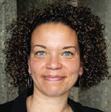
32 THE MB TEACHER | SPRING 2022
of person you are trying to be and make choices that emulate who you are wanting to be. For example, instead of asking what you need to do to be better at running, cooking, designing, etc., ask yourself, what would a professional runner/chef/engineer do in this situation? And then, do just that!
SANDY WELBERGEN
PTTA
I don’t listen to podcasts every day, but here are my faves, past and present!
The Daily is a short, informative podcast written by the journalists at the New York Times. The topics are always current, and often offer new perspectives or in-depth reporting on events. It runs 5 days a week. The Anthropocene Reviewed is a podcast by bestselling YA author John Green. The podcast went on hiatus in 2020 while John took the time to turn the podcast into a book. Always informative and entertaining!
13 Minutes to the Moon Season one takes an incredible, suspenseful dive into the story behind Apollo 11’s lunar landing; specifically through the last 13 minutes of the flight. Season two does the same with the near-disastrous Apollo 13 mission. It’s riveting!
Carrier is the first serial fiction podcast I ever listened to. I tuned in on a drive across the prairies and back again. It tells the story of a young, female truck driver filling in for
her sick father, and her mysterious cargo!
Thanks, it’s Thrifted is a great little podcast that feeds into my COVID-19 fueled obsession with thrifting! The hosts, Dina & Sharon are avid thrifters and discuss the trials, tribulations and celebrations associated with shopping second-hand. They also explore the science, sociology and psychology behind our wasteful habits.
MARIA NICKEL
ITA
A podcast I’m into right now is For the Wild: An Anthology of the Anthropocene. Simple yet colorful language is used with a gentle but informative tone throughout it all. I can picture what she talks about vividly. Great storytelling without being preachy. I could listen to her voice all day, very soothing and calming. I like how she weaves her profession as a botany professor and poetic storytelling. Really good.
MIKE NANTAIS BU PROFESSOR
My podcast listening is not confined to summer – but whose is? One podcast my wife and I listen to when travelling is a CBC program called Under the Influence with Terry O’Reilly. This podcast is based on the host’s work in advertising and covers a wide range of topics. Terry is easy to listen to and can tell a
fascinating story connecting various events to the world of advertising. I always learn something and am certainly entertained listening to this podcast!

ZACH SCHNITZER MTS STAFF
Apart from my own Let’s Go Bombers podcast, which I’m quite partial to, here are my favourites.
Cultivating Connection with KG Education is a great podcast created and hosted by KG Education founders and Manitoba educators Devon Caldwell and Leah Obach. Interviews with area experts and self-care practices inspire listeners in the areas of wellness, professional growth, and community-building.

Dare to Lead with Brené Brown is a podcast that inspires leaders to create safe and effective workgroups to build a better and more just world. Dr. Brown shares her thoughts and has “daring” conversations with a range of courageous innovators and culture-shifters.

From science-based techniques to manage anxiety, improve relationships, and enhance or develop your meditation practice, to the emerging field of psychedelics, The 10% Happier Podcast by former ABC News anchor, now journalist Dan Harris, is sure to enlighten, educate, and entertain.

Look for Great Fall Podcasts part 2 in this series of podcast recommendations, in the fall MB Teacher

SPRING 2022 | THE MB TEACHER 33
BOOK REVIEWS
By Curtis Lowton, LRTA
Author: Dr. Julie Smith Publisher: HarperOne (2022)
If you are a social media user, then you may already be familiar with psychologist and author Dr. Julie Smith. Followed by over three million people, Smith creates short TikTok videos that provide insights into psychotherapy. More substantial value can be found in Smith’s first book, Why Has Nobody Told Me This Before?, which provides practical information and clinical research on various mental health coping strategies. And while one can choose to read the book from cover to cover, the book’s most useful feature is that it is divided into sections, such as motivation, grief, stress, emotional pain and self-doubt. These passages can be read and re-read as needed like a mental wellness manual, or as Smith says, “a toolbox filled to the brim with
WHY HAS NOBODY TOLD ME THIS BEFORE? ME AND WHITE SUPREMACY
Author: Layla F. Saad Publisher: Sourcebooks (2020)
Layla F. Saad administers a master class in anti-racism and white supremacy in Me and White Supremacy: Combat Racism, Change the World, and Become a Good Ancestor. Saad clarifies early in the book: “The system of white supremacy was not created by anyone who is alive today. But it is maintained and upheld by everyone who holds white privilege—whether or not you want it or agree with it.”
Over the course of 28 “days”, Saad dissects topics such as white silence, tone policing, color blindness, tokenism, and more. And before each daily chapter, Saad includes rousing quotes from other anti-racism activists and BIPOC writers, guaranteed to make your TBR (the acronym for your “to be
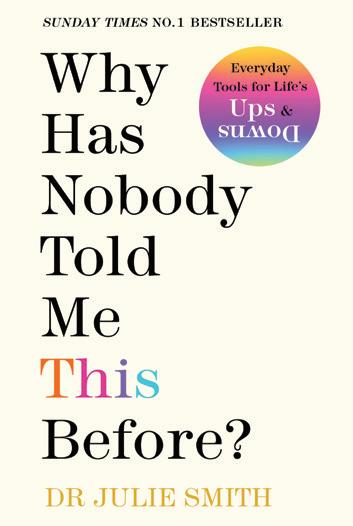
different tools for different jobs.”
Unsure if this book is for you? Log into your TikTok account (or someone else’s) and watch a handful of Smith’s videos. I recommend the January 19 entry, where Smith uses a jug of water, a running hose and a power drill to exemplify the relationship between stress and resiliency factors. You will be eager to learn more skills for yourself as well as for your students, colleagues, friends, and family.
But take note: just as a fitness trainer is no substitute for a doctor, Why Has Nobody Told Me This Before? is not a replacement for the professional therapeutic relationship offered by a counsellor. However, it can enlighten you on how to bolster your mental welfare, or to identify problematic themes to work through with a therapist.
read” reading pile) much longer.
What truly elevates White Supremacy and Me is the inclusion of reflective journal prompts at the end of each day. Saad pulls no punches, confronting the white reader with uncompromising provocations like: “How does your white fragility show up during conversations about race?”, “How have you profited (socially or financially) from cultural appropriation?” and “How have you centered yourself as a person with white privilege in non-white spaces and conversations?”
Saad’s hard-line questioning will unnerve some readers, while others will find Saad’s writing style to be effective for building an increased awareness of one’s own white fragility and white centering.
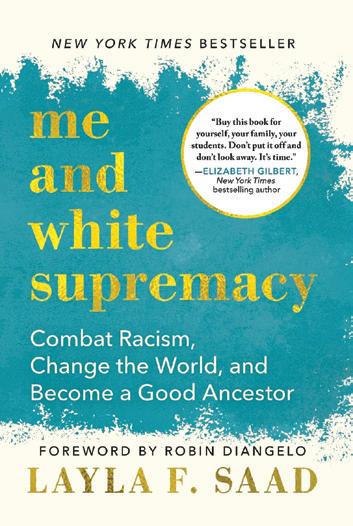
34 THE MB TEACHER | SPRING 2022
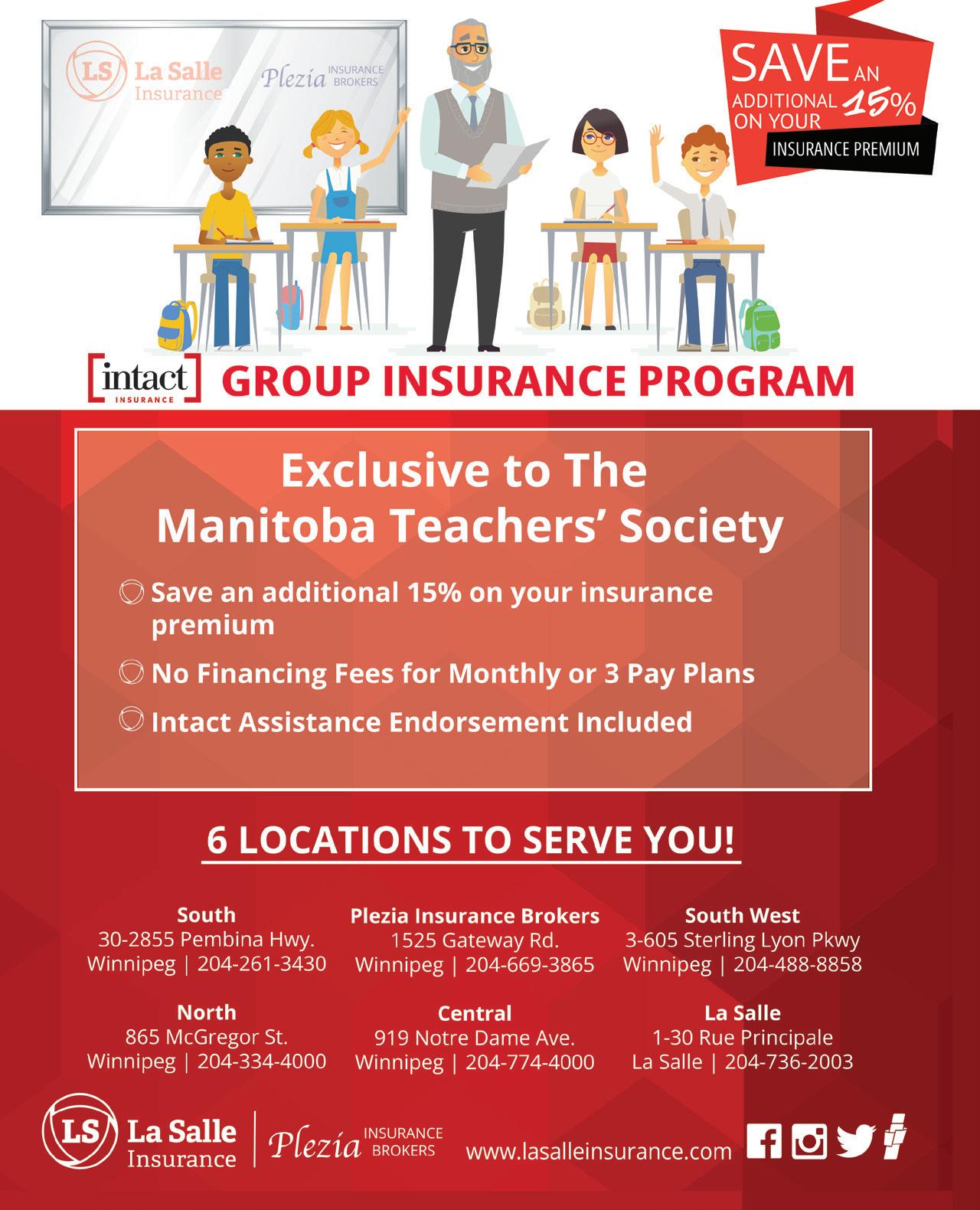
Canada’s Largest 5G Network on Canada’s Most Reliable Network.*

Save on unlimited data to share across all your devices with a Rogers Infinite TM plan. Get 20, 30 or 40 GB of max speed data and reduced speeds thereafter. With no data overage charges, you can stream all the video, music and content you want, worry-free.
time offer,

Limited
subject to change without notice. A Setup Service Fee of $50 applies to setup your device and related services. Taxes extra. ± Where applicable, additional airtime, data, long distance, roaming, options and taxes are extra and billed monthly. However, there is no airtime charge for calls made to 9-1-1 from your Rogers wireless device. Plan includes calls and messages from Canada to [local/Canadian] numbers only. On the Rogers Network or in an Extended Coverage area, excluding calls made through Call Forwarding, Video Calling or similar services. Employee verification is required; Rogers reserves the right to request proof of employment from each individually paid employee at any time. A onetime Employee Pricing Fee of $50 may apply for existing customers. Existing customers with an in-market Rogers consumer plan with 6 months or less tenure on their term plan switching to the plan above are not eligible to receive this discount. This offer cannot be combined with any other consumer promotions and/or discounts unless made eligible by Rogers. *Rogers Infinite data plans include data at high speed up to the data bucket included in your plan on the Rogers network, when connected to extended coverage areas within Canada, and Roam Like Home destinations (see rogers.com/roamlikehome). 5G access included at no extra charge. 5G access requires a 5G-enabled device in an area where there is 5G coverage (see rogers.com/coverage). Once you have reached the high speed data allotment of your plan, you will continue to have access to data services with no overage beyond the high speed allotment at a reduced speed of up to 512 kilobits per second (for both upload and download) until the end of your current billing cycle. Applications such as email, web browsing, apps, and audio/video streaming will continue to function at a reduced speed which will likely impact your experience. We will send you a text message notifying you when you have used 90% and 100% of the high speed allotment included in your plan with the option to purchase a Speed Pass to add more high speed data to your plan. Plan requires registration for online billing. In all cases, usage is subject to the Rogers Terms of Service and Acceptable Use Policy, rogers.com/terms. © 2022 Rogers Communications. 30% OFF * 20% OFF * 20% OFF * 20% OFF * 20GB 30GB 40GB 40GB + US Plus get $0 down 0% interest on approved credit with financing on a Rogers InfiniteTM plan. Red Wireless 1-888-819-1007 vip@redwirelesss.ca Sign up today & Save! Visit the link below to view and access this offer and many more. Please be advised you will have to provide proof of employment in the form of your work email or pay stub. www.redwireless.ca/mbteachers All of Manitoba School Division employees get a discount on Rogers Infinite TM plans









































 By Christine Deckert, LRTA
By Christine Deckert, LRTA














































































